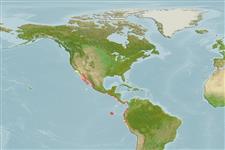Classificação / Names
Common names from other countries
Referência principal
Tamanho / Peso / Idade
Max length : 71.0 cm TL macho/indeterminado; (Ref. 40637); Peso máx. publicado: 13.0 kg (Ref. 40637)
Length at first maturity
Lm ?, range 19 - 20 cm
Ambiente
; marinhas; estuarina associadas(os) a recifes; intervalo de profundidade 3 - 60 m (Ref. 9313)
Clima / Intervalo
Subtropical, preferred 27°C (Ref. 107945); 36°N - 13°S, 120°W - 77°W (Ref. 55)
Distribuição
Descrição breve
Espinhos dorsais (total): 10; Raios dorsais moles (total): 14; Espinhos anais 3; Raios anais moles: 8. Forehead slopes steeply; snout somewhat pointed. Preopercular notch and knob weak. Scale rows on back parallel with lateral line. Rosy red anteriorly, becoming bright orange to yellow over most of the body; the fins are mainly yellow or orange; the inside of the mouth is white; a bluish horizontal streak runs below the eye.
Categoria na Lista Vermelha da IUCN (Ref. 115185)
Ameaça para o homem
Harmless
Utilização humana
Pescarias: espécies comerciais; Aquacultura: experimental
Mais informação
ReferênciasAquaculturaPerfil para aquaculturaEstirpesGenéticaFrequência dos alelosHereditariedadeDoençasProcessamentoMass conversion
ColaboradoresFotografiasStamps, CoinsSonsCiguateraVelocidadeTipo de nataçãoÁrea branquialOutras referênciasCérebrosVisão
Ferramentas
Relatórios especiais
Descarregue XML
Fontes da internet
Estimates of some properties based on models
Phylogenetic diversity index
PD50 = 0.5000 many relatives (e.g. carps) 0.5 - 2.0 few relatives (e.g. lungfishes)
Nível Trófico
4.0 ±0.63 se; Based on food items.
Resiliência
Baixo, tempo mínimo de duplicação da população 4,5 - 14 anos (K=0.15;)
Vulnerabilidade
High vulnerability (56 of 100)
Categoria de preço
